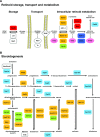Evolution of retinoid and steroid signaling: vertebrate diversification from an amphioxus perspective
- PMID: 21856648
- PMCID: PMC3184775
- DOI: 10.1093/gbe/evr084
Evolution of retinoid and steroid signaling: vertebrate diversification from an amphioxus perspective
Abstract
Although the physiological relevance of retinoids and steroids in vertebrates is very well established, the origin and evolution of the genetic machineries implicated in their metabolic pathways is still very poorly understood. We investigated the evolution of these genetic networks by conducting an exhaustive survey of components of the retinoid and steroid pathways in the genome of the invertebrate chordate amphioxus (Branchiostoma floridae). Due to its phylogenetic position at the base of chordates, amphioxus is a very useful model to identify and study chordate versus vertebrate innovations, both on a morphological and a genomic level. We have characterized more than 220 amphioxus genes evolutionarily related to vertebrate components of the retinoid and steroid pathways and found that, globally, amphioxus has orthologs of most of the vertebrate components of these two pathways, with some very important exceptions. For example, we failed to identify a vertebrate-like machinery for retinoid storage, transport, and delivery in amphioxus and were also unable to characterize components of the adrenal steroid pathway in this invertebrate chordate. The absence of these genes from the amphioxus genome suggests that both an elaboration and a refinement of the retinoid and steroid pathways took place at the base of the vertebrate lineage. In stark contrast, we also identified massive amplifications in some amphioxus gene families, most extensively in the short-chain dehydrogenase/reductase superfamily, which, based on phylogenetic and genomic linkage analyses, were likely the result of duplications specific to the amphioxus lineage. In sum, this detailed characterization of genes implicated in retinoid and steroid signaling in amphioxus allows us not only to reconstruct an outline of these pathways in the ancestral chordate but also to discuss functional innovations in retinoid homeostasis and steroid-dependent regulation in both cephalochordate and vertebrate evolution.
Figures




References
-
- Albalat R. The retinoic acid machinery in invertebrates: ancestral elements and vertebrate innovations. Mol Cell Endocrinol. 2009;313:23–35. - PubMed
-
- Albalat R, Cañestro C. Identification of Aldh1a, Cyp26 and RAR orthologs in protostomes pushes back the retinoic acid genetic machinery in evolutionary time to the bilaterian ancestor. Chem Biol Interact. 2009;178:188–196. - PubMed
-
- Albiston AL, Obeyesekere VR, Smith RE, Krozowski ZS. Cloning and tissue distribution of the human 11 β-hydroxysteroid dehydrogenase type 2 enzyme. Mol Cell Endocrinol. 1994;105:R11–R17. - PubMed
-
- Baker ME. Co-evolution of steroidogenic and steroid-inactivating enzymes and adrenal and sex steroid receptors. Mol Cell Endocrinol. 2004a;215:55–62. - PubMed
Publication types
MeSH terms
Substances
LinkOut - more resources
Full Text Sources

